Falmouth Field Trip 2014-
This website reflects the opinions of students and not the views of the University of Southampton or the National Oceanography Centre.
Produced by: Alice Duff, Philippa Fitch, Joanna Gordon, William Harris, Thomas Jefferson,
Eirian Kettle, Jesse Marshall, Dominique Mole, Emma-
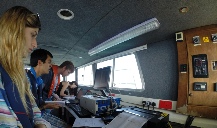
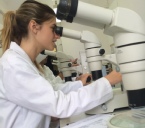
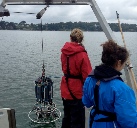
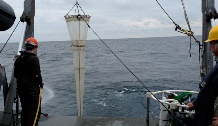



Estuary
Aim
Investigate chemical and physical processes and how these interact with planktonic species, horizontally over the length of the estuary and vertically at each station.
Objectives
Determine physical structures (temperature, salinity and current) within the estuary using an ADCP and CTD rosette.
Investigate changes in nutrient concentrations (nitrate, phosphate and dissolved silicon).
Determine species and abundance of phytoplankton and zooplankton in the lower, mid and upper estuary using zooplankton nets and water samples preserved
Introduction
Estuaries are complex systems which provide a range of services (Thrush et al., 2013). Investigating physical, chemical and biological estuarine features is therefore essential to understanding the systems comprehensively. Chemically, estuaries are important research areas as waters with different chemical compositions mix rapidly within estuaries (Liss and Pointon, 1972). Physical factors in estuaries (vertical and horizontal structures and currents) are also interesting due to the interactions of two water bodies. The conditions within estuaries result in these environments acting as important habitats for many types of biota. In order to gain a greater understanding of processes within the Fal estuary, an investigation measuring multiple parameters was completed.
Methods
A survey was carried out along the Falmouth Estuary aboard the Conway on the 26th June 2014. Weather conditions varied between periods of heavy rain and sun. Low tide was at 11:04 UTC. Due to this stations were sampled from head to the mouth of the estuary. At each station transects were completed measuring current velocity using an ADCP and vertical profiles of multiple parameters were recorded using a CTD rosette. Water samples were collected and contamination was reduced as much as possible when dispensing samples into appropriate storage bottles on the boat. A secchi disc was used at each station in order to indicate light penetration. A zooplankton net was also used to determine abundance of zooplankton species at 3 different stations.
The stations sampled were at the locations shown in Figure 1.
Water samples were analysed in the lab on the 27th June 2014. Dissolved oxygen concentrations were determined using the Winkler method (Grasshoff et al., 1999). Dissolved silicon, phosphate and chlorophyll concentrations were measured using the methods outlined by Parsons et al. (1984). Nitrate was analysed by flow injection analysis (Johnson and Petty, 1983).
See Appendix for further detail.
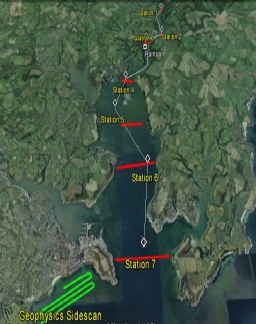
Figure 1 -
Click to enlarge
| Geophysics |
| References |
| Introduction |
| Physical |
| Chemical |
| Biological |
| References |
| Introduction |
| Results |
| References |
| Introduction |
| Physical |
| Chemical |
| Biological |
| References |